The United States government is likely to back the dollar with bitcoin in order to protect its status as issuer of the global reserve currency.
This is an opinion editorial by Luke Mikic, a writer, podcast host and macro analyst.
This is the second part in a two-part series about the Dollar Milkshake Theory and the natural progression of this to the “Bitcoin Milkshake.” In this piece, we’ll explore where bitcoin fits into a global sovereign debt crisis.
The Bitcoin Milkshake Theory
Most people believe the monetization of bitcoin will most hurt the United States as it’s the country with the current global reserve currency. I disagree.
The monetization of bitcoin benefits one nation disproportionally more than any other country. Like it, welcome it or ban it, the U.S. is the country that will benefit most from the monetization of bitcoin. Bitcoin will help to extend the life of the USD longer than many can conceptualize and this article explains why.
If we move forward on the assumption that the Dollar Milkshake Thesis continues to decimate weaker currencies around the world, these countries will have a decision to make when their currency goes through hyperinflation. Some of these countries will be forced to dollarize, like the more than 65 countries that are either dollarized or have their local currency pegged to the U.S. dollar.
Some may choose to adopt a quasi-gold standard like Russia recently has. Some may even choose to adopt the Chinese yuan or the euro as their local medium of exchange and unit of account. Some regions could copy what the shadow government of Myanmar have done and adopt the Tether stablecoin as legal tender. But most importantly, some of these countries will adopt bitcoin.
For the countries that may adopt bitcoin, it will be too volatile to make economic calculations and use as a unit of account when it’s still so early in its adoption curve.
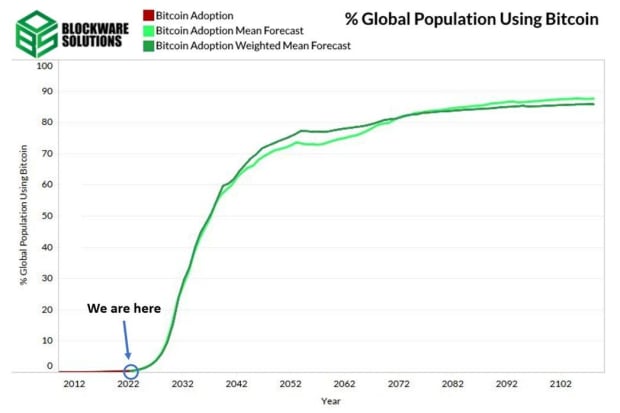
Despite what the consensus narrative is surrounding those who say, “Bitcoin’s volatility is decreasing because the institutions have arrived,” I strongly believe this is not a take rooted in reality. In a previous article written in late 2021 analyzing bitcoin’s adoption curve, I outlined why I believe the volatility of bitcoin will continue to increase from here as it travels through $500,000, $1 million and even $5 million per coin. I think bitcoin will still be too volatile to use as a true unit of account until it breaches eight figures in today’s dollars — or once it absorbs 30% of the world’s wealth.
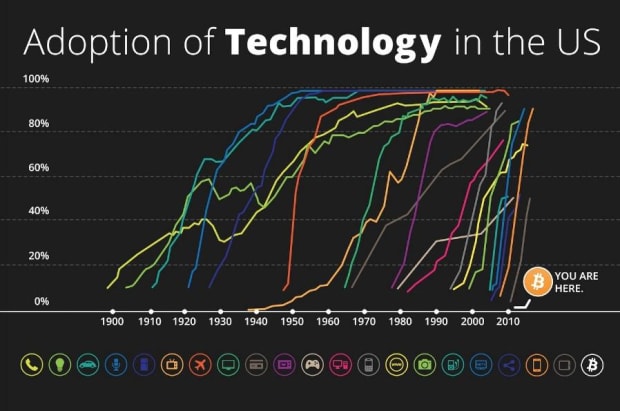
For this reason, I believe the countries who will adopt bitcoin, will also be forced to adopt the U.S. dollar specifically as a unit of account. Countries adopting a bitcoin standard will be a Trojan horse for continued global dollar dominance.
Put aside your opinions on whether stablecoins are shitcoins for just a second. With recent developments, such as Taro bringing stablecoins to the Lightning Network, imagine the possibility of moving stablecoins around the world, instantly and for nearly zero fees.
The Federal Reserve of Cleveland seems to be paying close attention to these developments, as they recently published a paper titled, “The Lightning Network: Turning Bitcoin Into Money.”
Zooming out, we can see that since March 2020, the stablecoin supply has grown from under $5 billion to over $150 billion.

What I find most interesting is not the rate of growth of stablecoins, but which stablecoins are growing the fastest. After the recent Terra/LUNA debacle, capital fled from what’s perceived to be more “risky” stablecoins like tether, to more “safe” ones like USDC.

This is because USDC is 100% backed by cash and short-term debt.
BlackRock is the world's largest asset manager and recently headlined a $440 million fundraising round by investing in Circle. But it wasn’t just a funding round; BlackRock is going to be acting as the primary asset manager for USDC and their treasury reserves, which is now nearly $50 billion.

The aforementioned Tether appears to be following in the footsteps of USDC. Tether has long been criticized for its opaqueness and the fact it’s backed by risky commercial paper. Tether has been viewed as the unregulated offshore U.S. dollar stablecoin. That being said, Tether sold their riskier commercial paper for more pristine U.S. government debt. They also agreed to undergo a full audit to improve transparency.
If Tether is true to their word and continues to back USDT with U.S. government debt, we could see a scenario in the near future where 80% of the total stablecoin market is backed by U.S. government debt. Another stablecoin issuer, MakerDao, also capitulated this week, buying $500 million government bonds for its treasury.
It was crucial that the U.S. dollar was the main denomination for bitcoin during the first 13 years of its life during which 85% of the bitcoin supply had been released. Network effects are hard to change, and the U.S. dollar stands to benefit most from the proliferation of the overall “crypto” market.
This Bretton Woods III framework correctly describes the issue facing the United States: The country needs to find someone to buy their debt. Many dollar doomsayers assume the Fed will have to monetize a lot of the debt. Others say that increased regulations are on the way for the U.S. commercial banking system, which was regulated to hold more Treasurys in the 2013-2014 era, as countries like Russia and China began divesting and slowing their purchases. However, what if a proliferating stablecoin market, backed by government debt, can help soak up that lost demand for U.S. Treasurys? Is this how the U.S. finds a solution to the unwinding petrodollar system?
Interestingly, the U.S. needs to find a solution to its debt problems, and fast. Nations around the world are racing to escape the dollar-centric petrodollar system that the U.S. for decades has been able to weaponize to entrench its hegemony. The BRICS nations have announced their intentions to create a new reserve currency and there are a host of other countries, such as Saudi Arabia, Iran, Turkey and Argentina that are applying to become a part of this BRICS partnership. To make matters worse, the United States has $9 trillion of debt that matures in the next 24 months.
Who is now going to buy all that debt?
The U.S. is once again backed into a corner like it was in the 1970s. How does the country protect its nearly 100-year hegemony as the global reserve currency issuer, and 250-year hegemony as the globe’s dominant empire?
Currency Wars And Economic Wild Cards
This is where the thesis becomes a lot more speculative. Why is the Fed continuing to aggressively raise interest rates, bankrupting its supposed allies like Europe and Japan, while seemingly sending the world into a global depression? “To fight inflation,” is what we’re told.
Let’s explore an alternative, possible reason why the Fed could be raising rates so aggressively. What options does the U.S. have to defend its hegemony?
In a world currently under a hot war, would it seem so far-fetched to speculate that we could be entering an economic cold war? A war of central banks, if you will? Have we forgotten about the “weapons of mass destruction?” Have we forgotten what we did to Libya and Iraq for attempting to route around the petrodollar system and stop using the U.S. dollar in the early 2000s?

Until six months ago, my base case was that the Fed and central banks around the globe would act in unison, pinning interest rates low and use the “financial repression sandwich” to inflate away the globe’s enormous and unsustainable 400% debt-to-GDP ratio. I expected them to follow the economic blueprints laid out by two economic white papers. The first one published by the IMF in 2011 titled, “The Liquidation Of Government Debt” and then the second paper published by BlackRock in 2019 titled, “Dealing With The Next Downturn.”
I also expected all the central banks to work in tandem to move toward implementing central bank digital currencies (CBDCs) and working together to implement the “Great Reset.” However, when the data changes, I change my opinions. Since the creepingly coordinated policies from governments and central banks around the world in early 2020, I think some countries are not so aligned as they once were.
Until late 2021, I held a strong view that it was mathematically impossible for the U.S. to raise rates — like Paul Volcker did in the 1970s — at this stage of the long-term debt cycle without crashing the global debt market.
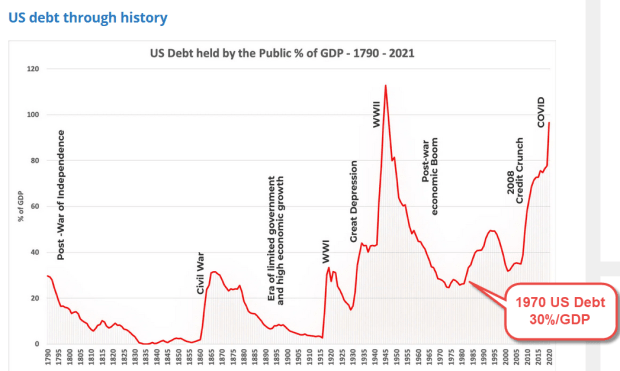
But, what if the Fed wants to crash the global debt markets? What if the U.S. recognizes that a strengthening dollar causes more pain for its global competitors than for themselves? What if the U.S. recognizes that they would be the last domino left standing in a cascade of sovereign defaults? Would collapsing the global debt markets lead to hyperdollarization? Is this the only economic wild card the U.S. has up its sleeve to prolong its reign as the dominant global hegemon?

While everyone is waiting for the Fed pivot, I think the most important pivot has already happened: the Dalio pivot.
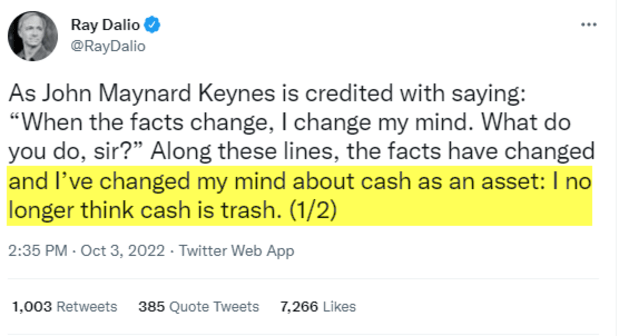
As a Ray Dalio disciple, I’ve built my entire macroeconomic framework on the idea that “cash is trash.” I believe that mantra still holds true for anyone using any other fiat currency, but has Dalio stumbled upon some new information about the USD that has changed his mind?
Dalio wrote a phenomenal book “The Changing World Order: Why Nations Succeed or Fail” that details how wars occur when global empires clash.
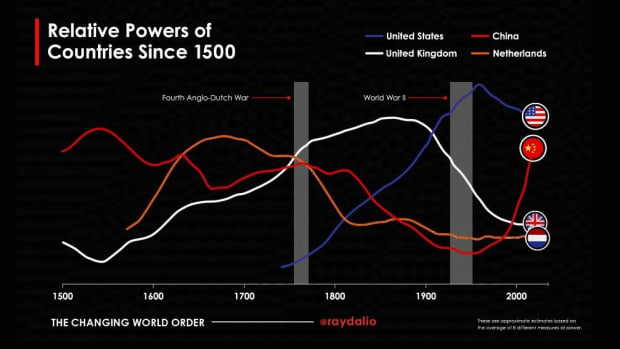
Has he concluded that the United States could be about to weaponize the dollar, making it not so trashy? Has he concluded that the U.S. isn’t going to willingly allow China to be the world’s next rising empire like he once proclaimed? Would the U.S. aggressively raising rates lead to a capital flight to the U.S., a country that has a comparatively healthier banking system than its competitors in China, Japan and Europe? Do we have any evidence for this outlandish left-field, hypothetical scenario?
Let’s also not forget, this is not just a race with the United States versus China. The second-most used foreign currency in the world — the euro — probably wouldn’t mind gaining power from a declining U.S. empire. We have to ask the question, why is Jerome Powell refusing to align monetary policies with one of our closest allies in Europe?

In this illuminating 2021 webinar, at the Green Swan central banking conference, Powell blatantly refused to go along with the “green central banking” policies that were discussed. This visibly infuriated Christine Lagarde, head of the European Central Bank, who was also part of the event.

Some of the quotes from Powell in that interview are illuminating.
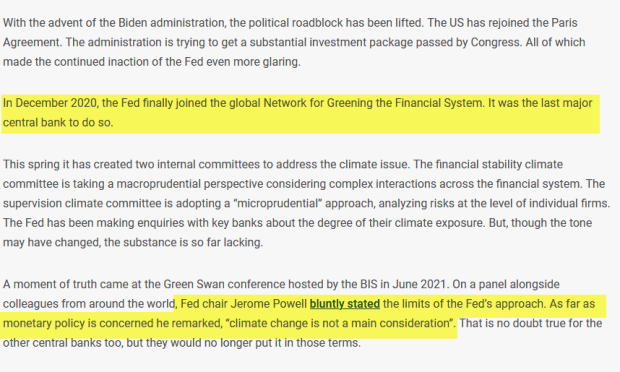

Is this a sign the U.S. is no longer a fan of the Great Reset ideologies coming out of Europe? Why is the Fed also ignoring the United Nations begging them to lower rates?
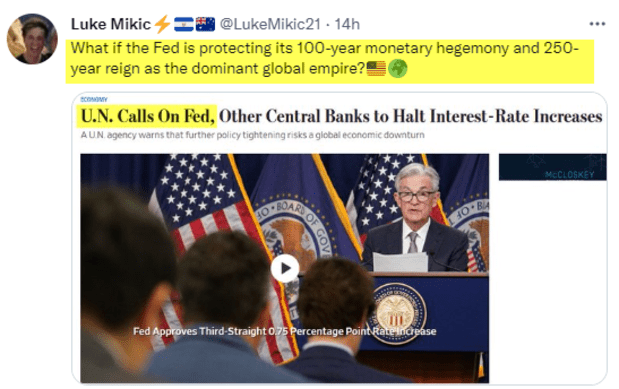
We can speculate about what Powell’s intentions may be all day, but I prefer to look at data. Since Powell’s initial heated debate with Lagarde and the Fed’s subsequent rate increase on the reverse repo days after, the dollar has decimated the euro.
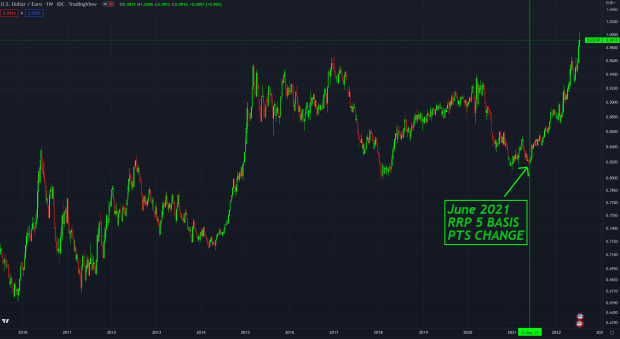
In April 2022, Powell was dragged into another “debate” with Lagarde, led by the head of the IMF. Powell reaffirmed his stance on climate change and central banking.
The plot thickens when we consider the implications of the LIBOR and SOFR interest rate transition that occurred at the beginning of 2022. Will this interest rate change enable the Fed to hike interest rates and insulate the banking system from the contagion that’ll ensue from a wave of global debt defaults in the wider eurodollar market?

I do think it’s interesting that by some metrics the U.S. banking system is showing comparatively fewer signs of stress than in Europe or the rest of the world, validating the thesis that SOFR is insulating the U.S. to a degree.
A New Reserve Asset
Whether the U.S. is at war with other central banks or not doesn’t change the fact that the country needs a new neutral reserve asset to back the dollar. Creating a global deflationary bust, and weaponizing the dollar is only a short-term play. Scooping up assets on the cheap and weaponizing the dollar will only force dollarization in the short term. The BRICS nations and others that are disillusioned with the SWIFT-centered financial system will continue to de-dollarize and try to create an alternative to the dollar.
The global reserve currency has been informally backed by the U.S. Treasury note for the past 50 years, since Nixon closed the gold window in 1971. In times of risk, people run to the reserve asset as a way to get a hold of dollars. For the past 50 years, when equities sell off, investors fled to the “safety” of bonds which would appreciate in “risk off” environments. This dynamic built the foundation of the infamous 60/40 portfolio — until this trade ultimately broke in March 2020 when the Treasury market became illiquid.

As we transition into the Bretton Woods III era, the Triffin dilemma is finally becoming untenable. The U.S. needs to find something to back the dollar with. I find it unlikely that they will back the dollar with gold. This would be playing into the hands of Russia and China who have far larger gold reserves.
This leaves the U.S. with their backs against a wall. Faith is being lost in the dollar and they would surely want to retain their global reserve currency status. The last time the U.S. was in a similarly vulnerable position was in the 1970s with high inflation. It looked like the dollar would fail until the U.S. effectively pegged the dollar to oil through the petrodollar agreement with the Saudis in 1973.
The country is faced with a similar conundrum today but with a different set of variables. They no longer have the option of backing the dollar with oil or gold.
Enter Bitcoin!
Bitcoin can stabilize the dollar and even prolong its global reserve currency status for much longer than many people expect! Most importantly, bitcoin gives the U.S. the one thing it needs for the 21st-century monetary wars: trust.
Countries may trust a gold-backed (petro-)ruble/yuan more than a dollar backed by worthless paper. However, a bitcoin-backed dollar is far more trustworthy than a gold-backed (petro-)ruble/yuan.
As mentioned earlier, the monetization of bitcoin not only helps the U.S. economically, but it also directly hurts our monetary competitors, China and to a lesser degree, Europe — our supposed ally.
Will the U.S. realize that backing the dollar with energy directly hurts China and Europe? China and Europe are both facing significant energy-related headwinds and have both infamously banned Bitcoin’s proof-of-work mining. I made the case that the energy crisis in China was the real reason China banned bitcoin mining in 2021.
Today, as we transition into the digital age, I believe a fundamental shift is coming:
For thousands of years, money has been backed by trust and gold, and protected by ships. However, in this millennium, money will now be backed by encryption and math, and protected by chips.
If you will allow me to once again engage in some speculation, I believe the U.S. understands this reality, and is preparing for a deglobalized world in many different ways. The U.S. appears to be the Western nation taking the friendliest approach to Bitcoin. We have senators all across the U.S. tripping over themselves to make their states Bitcoin hubs by enacting friendly regulation for mining. The great hash migration of 2021 has seen the lion’s share of the Chinese hash being transferred to the U.S., which now houses over 35% of the world’s hash rate.
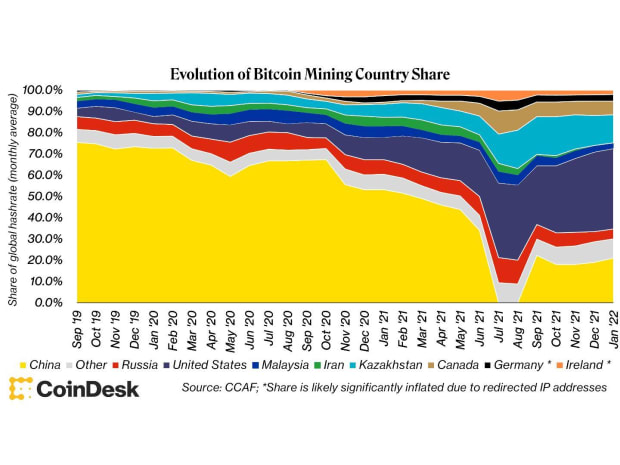
Recent sanctions on Russian miners could only further accelerate this hash migration. Apart from some noise in New York, and the delayed spot ETF decision, the U.S. looks as though it’s embracing bitcoin.
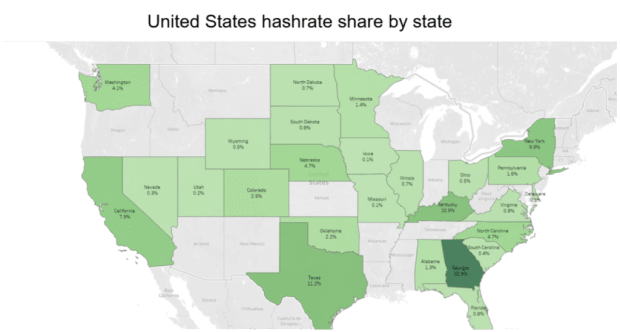
In this video, Treasury Secretary Janet Yellen talks about Satoshi Nakamoto’s innovation. The SEC Chair Gary Gensler continually differentiates Bitcoin from “crypto” and has also praised Satoshi Nakamoto’s invention.
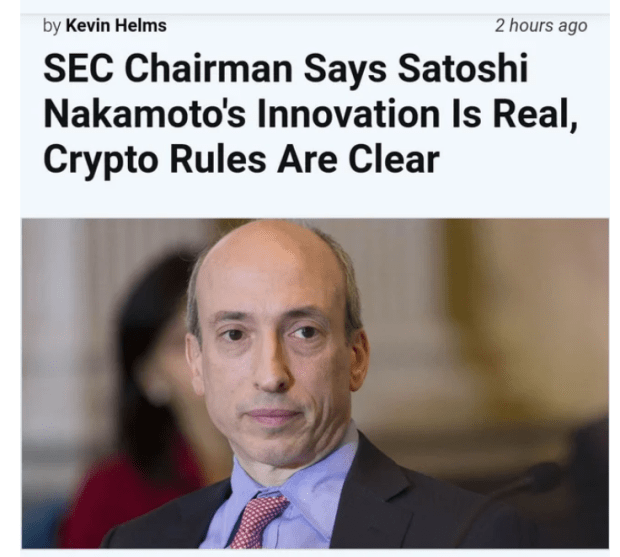
ExxonMobil is the largest oil company in the U.S. and announced it was using bitcoin mining to offset its carbon emissions.
Then there’s the question, why has Michael Saylor been allowed to wage a speculative attack on the dollar to buy bitcoin? Why is the Fed releasing tools highlighting how to price eggs (and other goods) in bitcoin terms? If the U.S. was so opposed to banning bitcoin, why has all of this been allowed in the country?
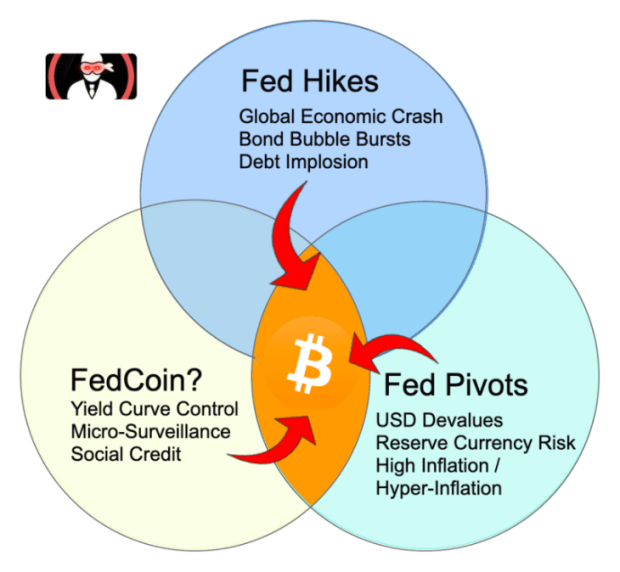
We’re transitioning from an oil-backed dollar to a bitcoin-backed dollar reserve asset. Crypto-eurodollars, aka stablecoins backed by U.S. debt, will provide the bridge between the existing energy-backed dollar system and this new energy-backed bitcoin/dollar system. I find it awfully poetic that the country founded on the ideology of freedom and self-sovereignty appears to be positioning itself to be the one that most takes advantage of this technological innovation. The bitcoin-backed dollar is the only alternative to a rising Chinese threat positioning for the global reserve currency.
Yes, the United States has committed many atrocities, I’d argue that at times they’ve been guilty of abusing their power as the global hegemon. However, in a world that’s being rapidly consumed by ramped totalitarianism, what happens if the mighty U.S. experiment fails? What happens to our civilization if we allow a social-credit-scoring Chinese empire to rise and export its CBDC-backed digital panopticon to the world? I was once one of these people cheering for the demise of the U.S. empire, but I now fear the survival of our very civilization is dependent upon the survival of the country that was originally founded on the principles of life, liberty and property.
Conclusions
Zooming out, I stand by my original thesis that we are in a new monetary order by the end of the decade. However, the events of the previous months have certainly accelerated that already-rapid 2030 timeline. I also stand by my original thesis from the 2021 article surrounding how bitcoin’s adoption curve unfolds because of how broken the current monetary regime is.

I believe 2020 was the monetary inflection point that will be the catalyst that takes bitcoin from 3.9% global adoption to 90% adoption this decade. This is what crossing the chasm entails for all transformative technologies that reach mainstream penetration.

There will however be many “hopeful moments” along the way, like there was in the German Weimar hyperinflationary event of the 1920s.
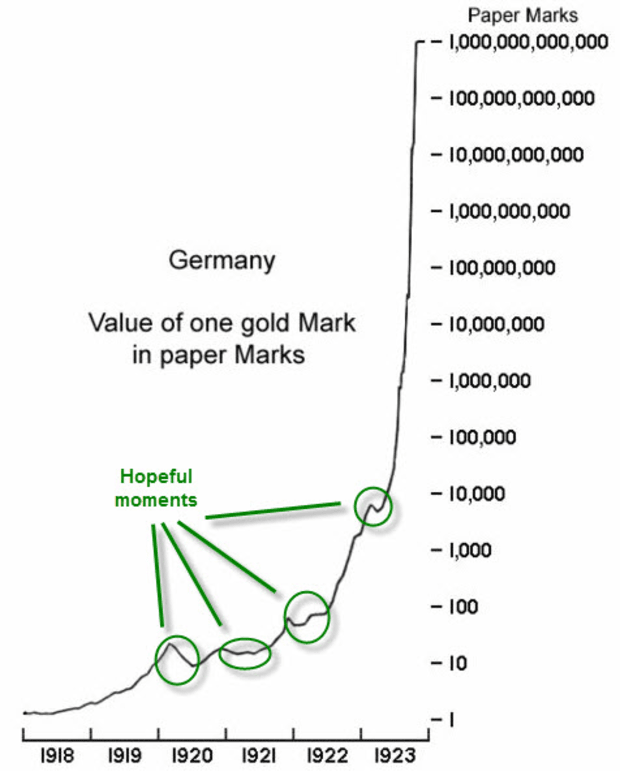
There will be dips and spikes in inflation, like there was in the 1940s during U.S. government deleveraging.
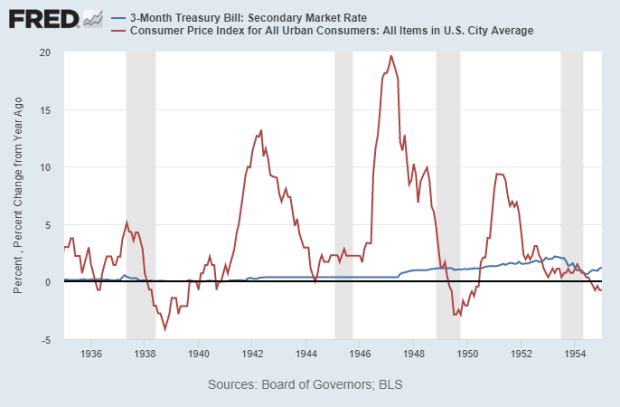
Deglobalization will be the perfect scapegoat for what was always going to be a decade of government debt deleveraging. The monetary contractions and spasms are becoming more frequent and more violent with each drawdown we encounter. I believe the majority of fiat currencies are in the 1917 stages of the Weimar hyperinflation.

This article was very centered on nation-state adoption of bitcoin, but don’t lose sight of what’s truly unfolding here. Bitcoin is a Trojan horse for freedom and self-sovereignty in the digital age. Interestingly, I also feel that hyperdollarization will accelerate this peaceful revolution.
Hyperinflation is the event that causes people to do the work and learn about money. Once many of these power-hungry dictators are forced to dollarize and no longer have the control of their local money printer, they may be more incentivized to take a bet on something like bitcoin. Some may even do it out of spite, not wanting to have their monetary policy dictated to them by the U.S.

Money is the primary tool used by states to exercise their autocratic, authoritarian powers. Bitcoin is the technological innovation that’ll dissolve the nation-state, and fracture the power the state has, by removing its monopoly on the money supply. In the same way the printing press fractured the power of the dynamic duo that was the church and state, bitcoin will separate money from state for the first time in 5,000+ years of monetary history.

So, to answer the dollar doomsdayers, “Is the dollar going to die?” Yes! But what will we see in the interim? De-dollarization? Maybe on the margins, but I believe we will see hyperdollarization followed by hyperbitcoinization.
This is a guest post by Luke Mikic. Opinions expressed are entirely their own and do not necessarily reflect those of BTC Inc or Bitcoin Magazine.
via bitcoinmagazine.com


